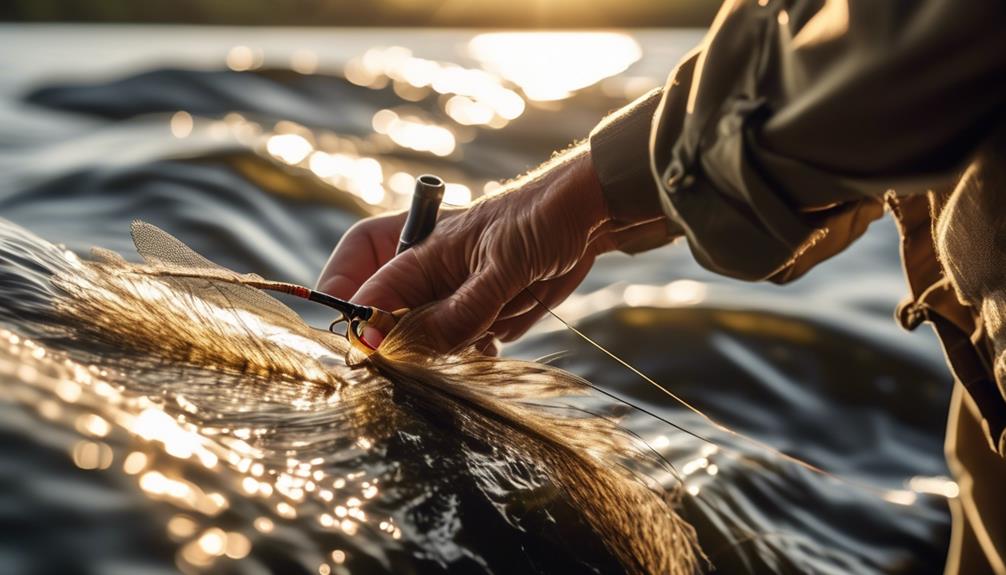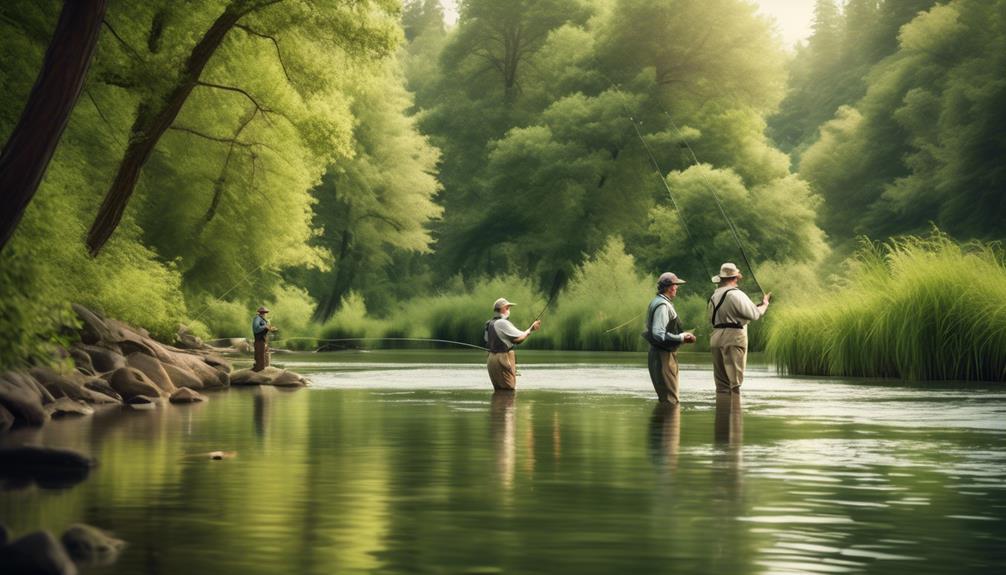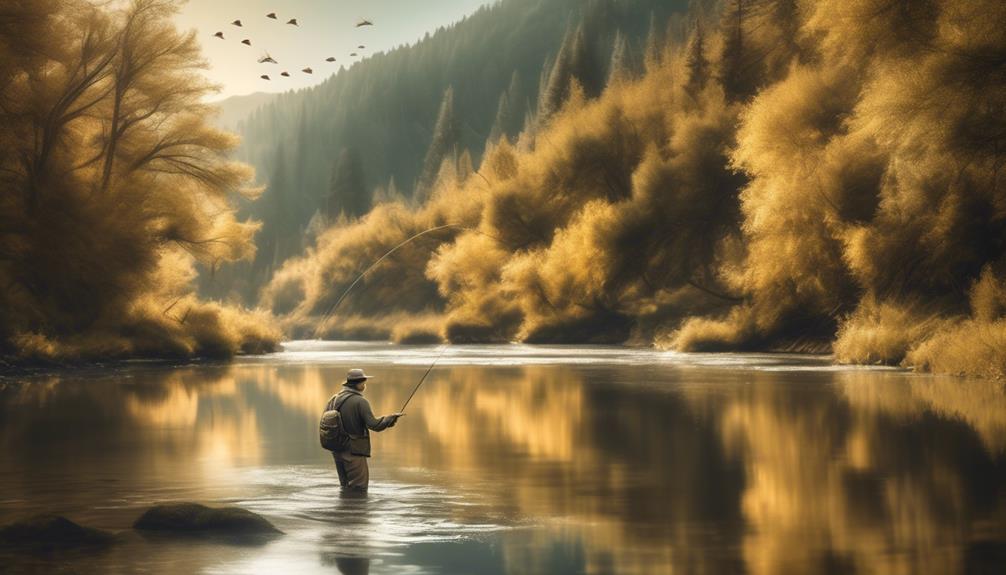When it comes to fly fishing, mastering the strategies is like unlocking a treasure chest of possibilities. Imagine having the ability to entice even the most elusive fish to bite, no matter the conditions.
As an angler, you understand the thrill of the chase, the satisfaction of a well-executed cast, and the anticipation of a strike.
In this expert insights guide, you'll gain access to top fly fishing strategies that have been carefully curated by seasoned anglers. These strategies are not just about catching fish, but about truly understanding the art and science of fly fishing.
So, are you ready to elevate your fly fishing game and reel in those trophy catches with finesse and expertise?
Essential Gear for Fly Fishing
When it comes to fly fishing, having the right gear is essential for success on the water. Proper gear maintenance not only prolongs the life of your equipment but also ensures that it performs optimally when you need it most.
Before heading out, it's crucial to check your gear for any signs of wear and tear, such as frayed lines or rusted hooks. Keeping your gear clean and well-maintained will prevent any unexpected malfunctions while you're out on the water.
In addition to maintaining your gear, mastering proper wading techniques is essential for navigating the waters effectively. Knowing how to wade properly not only improves your stability but also reduces the disturbance you create in the water, preventing fish from being spooked.
When wading, it's important to move slowly and deliberately, using the current to your advantage. By learning to read the water and understanding how to position yourself for the best casting angles, you can significantly improve your chances of a successful fishing outing.
Selecting the Right Fly
After ensuring your gear is well-maintained, the next crucial step in fly fishing success is selecting the right fly for the conditions and target species. Matching flies to the specific insects or baitfish present in the water is essential for enticing bites. For example, during the spring and summer months, when aquatic insects are abundant, using imitative flies such as mayfly or caddis imitations can be highly effective. In contrast, during the fall, terrestrial insects like grasshoppers or ants become more prevalent, so using patterns that mimic these insects can yield better results.
Seasonal variations play a significant role in determining the right fly for the conditions. In the spring, when water temperatures are cooler, using smaller and more natural-colored flies can be effective, as fish tend to be more selective. As the water warms up in the summer, larger, more vibrant flies might be more successful in catching the attention of fish. In the fall, as fish prepare for the winter and feed more voraciously, using streamers to imitate baitfish can be highly productive.
Understanding the life cycles of insects and the feeding habits of the target species in different seasons will help you make informed decisions when selecting the right fly. By paying attention to these factors and being adaptable in your approach, you can significantly increase your chances of a successful fly fishing outing.
Casting Techniques for Success
To improve your fly fishing success, mastering effective casting techniques is essential. Line control plays a crucial role in presenting your fly accurately to the fish. One key technique for maintaining line control is the reach cast. As you make your forward cast, extend your arm upstream or downstream, allowing the fly to land first and the line to follow, resulting in a natural drift. This technique is particularly useful when dealing with tricky currents or when you need to avoid spooking the fish.
When it comes to distance casting, proper technique can make all the difference. Start by ensuring that you have the right amount of line outside the tip of your rod. As you begin your casting motion, accelerate smoothly, gradually increasing line speed. Just before your rod reaches its maximum load, execute a crisp stop, allowing the line to roll out and carry the fly to your desired target. Remember, it's not just about raw power; timing and technique are equally important.
Another key aspect of successful casting is the backcast. Efficient backcasting allows for better line control and helps in setting up a powerful forward cast. Practice keeping your backcast low and in a straight line to generate maximum line speed and distance.
Additionally, mastering the double haul technique can significantly increase your casting distance, allowing you to reach fish that were previously out of range.
Understanding Fly Hatches
Understanding the different fly hatches is essential for fly fishermen looking to match the hatch and effectively target feeding fish. Identifying insect species and knowing the timing of fly hatches during the fishing season are crucial for a successful fly fishing experience. When it comes to identifying insect species, it's important to observe the water and surrounding vegetation to determine which insects are present. Different species of flies hatch at different times, so being able to recognize the specific insects that fish are feeding on will greatly improve your chances of success.
Fishing season timing plays a significant role in understanding fly hatches. Different insects hatch at different times of the year, and sometimes even within a specific day. For example, mayflies are often prevalent in the spring, caddisflies in the summer, and midges in the winter. By understanding these patterns, you can anticipate when certain hatches are likely to occur and prepare accordingly.
To effectively identify fly hatches, keep a keen eye on the water's surface. Look for any signs of insect activity such as emerging flies, floating nymphs, or spent wings. Also, pay attention to the behavior of the fish as they feed on the surface. This can provide valuable clues about the type of insects that are hatching and being targeted by the fish.
Mastering the Art of Presentation
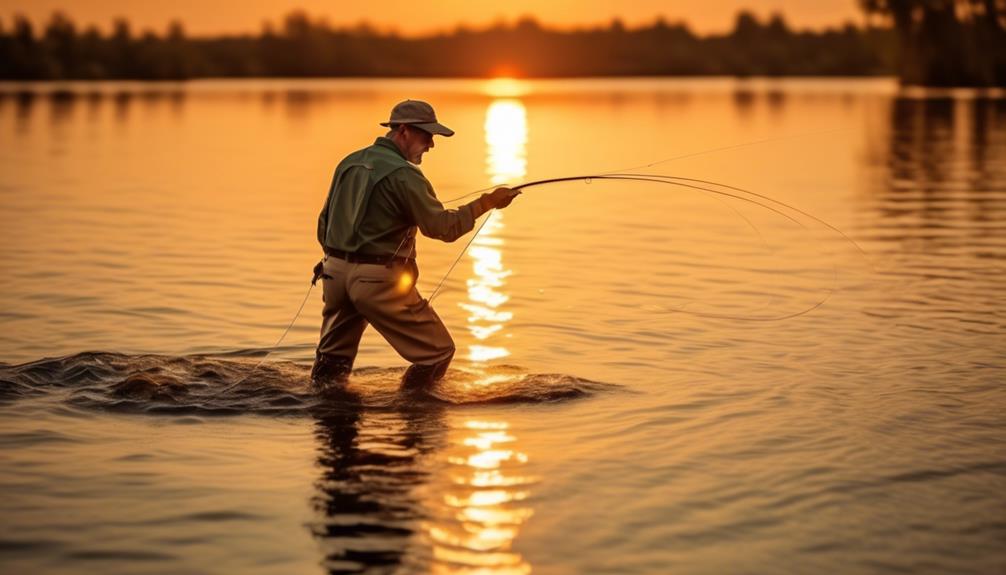
Mastering the art of presentation involves skillfully showcasing your fly to mimic the natural movements and behavior of the insects you observed during the hatch. To truly excel in this aspect of fly fishing, you need to pay attention to the finer details and make subtle adjustments to ensure that your presentation is as natural and enticing as possible.
To achieve this, focus on perfecting drift, which involves understanding the current and making sure your fly drifts naturally with the flow of the water. Reading water is also crucial; observe the subtle cues such as the speed and depth of the water, and look for feeding lanes or pockets where fish are likely to be present.
Additionally, mastering the art of mending is essential to ensure that your fly drifts naturally without any drag, which can deter fish from striking. Lastly, paying attention to the behavior of the insects during the hatch and using the appropriate fly pattern can significantly enhance your presentation.
Navigating Different Water Types
When faced with different water types while fly fishing, adjusting your approach is essential for success. River currents and lake shorelines present unique challenges that require specific strategies to navigate effectively.
When fishing in river currents, it's crucial to understand how the water's flow impacts the behavior of the fish. Look for slow-moving pockets behind rocks or along the banks where fish can conserve energy. Adjust your casting angle and mending techniques to present your fly naturally in these areas, as fish often position themselves to intercept food carried by the current.
On the other hand, lake shorelines demand a different approach. Focus on areas where natural features like fallen trees, submerged rocks, or aquatic vegetation provide cover and food sources for fish. These spots are prime feeding grounds, so casting parallel to the shoreline and retrieving your fly along the edges can yield great results. Pay attention to any surface activity or signs of feeding fish, as these indicators can guide your positioning and presentation.
In both river currents and lake shorelines, adapting your fly selection to mimic the prevalent food sources is crucial. Observing insect hatches, baitfish movement, or the presence of terrestrial insects can inform your choice of fly patterns.
Strategies for Catching Trophy Fish
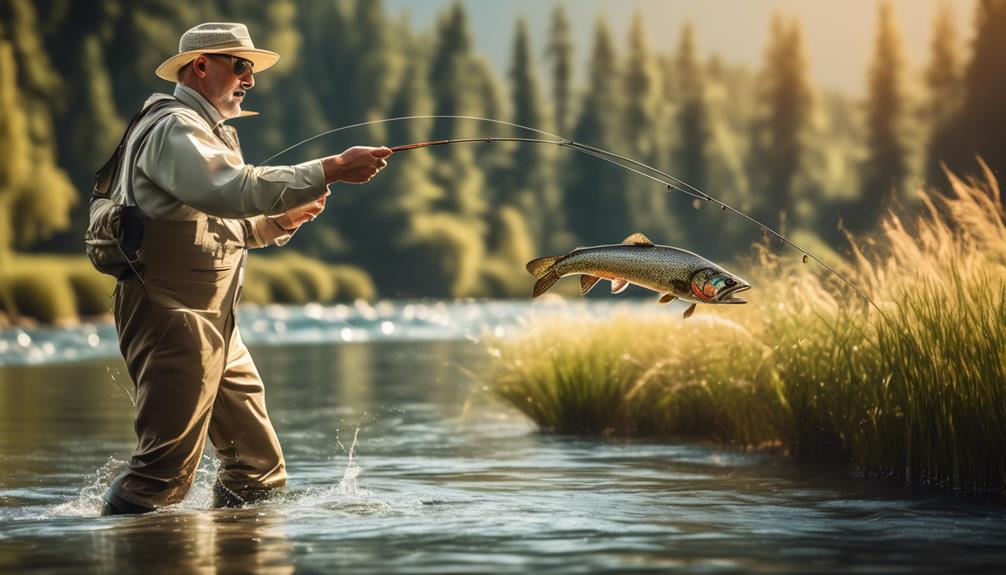
To catch trophy fish while fly fishing, focus on targeting prime feeding areas and using larger, more enticing fly patterns. When scouting for locations, look for areas where trophy fish are likely to congregate, such as deep pools, undercut banks, and submerged structure. Approach these areas stealthily to avoid spooking the fish, as trophy fish are often more wary and easily startled.
Understanding weather patterns and seasonal migrations is crucial for targeting trophy fish. Pay attention to changes in weather, as they can influence the behavior of trophy fish. Additionally, be mindful of seasonal migrations and the movements of baitfish, as trophy fish often follow these patterns in search of abundant food sources.
Incorporating larger and more realistic fly patterns can significantly increase your chances of landing a trophy fish. Experiment with streamers, leech patterns, and large nymphs to mimic the substantial prey that trophy fish seek. Vary your retrieval techniques to entice strikes from these elusive, larger fish.
Tips for Safely Releasing Fish
If you have successfully caught a fish and are planning to release it, follow these tips to ensure its safe return to the water. Proper fish handling is crucial for the ethical angler, and it starts with minimizing the time the fish spends out of the water. Keep the fish in the water as much as possible, even when removing the hook. If you need to handle the fish, make sure your hands are wet to avoid removing its protective slime layer, which can leave the fish vulnerable to infections.
When holding the fish, support its body gently and avoid putting pressure on its sensitive organs. If the fish needs reviving, hold it upright underwater and move it back and forth to allow water to flow through its gills. Be patient and wait for the fish to swim away on its own.
Using barbless hooks can also make the release process easier and less harmful to the fish. If the fish has swallowed the hook deeply, consider cutting the line instead of trying to retrieve the hook, as removing it may cause more harm. Checking your gear regularly and using the right equipment for the type of fish you're targeting can contribute to the safe release of your catch.
Frequently Asked Questions
What Are Some Common Mistakes That Beginner Fly Fishers Make and How Can They Avoid Them?
When starting out in fly fishing, it's common to make mistakes like poor casting or using the wrong fly. To avoid this, practice casting techniques and learn about local insect hatches. It'll boost your chances of a successful catch.
Are There Any Specific Strategies for Fly Fishing in Heavily Populated Areas or Areas With Heavy Fishing Pressure?
When urban fly fishing, use tactics like stealthy approach and precise casting to outsmart wary fish. High-pressure areas require techniques such as using smaller flies and varying retrieval speed to entice bites.
How Can I Improve My Ability to Read the Water and Find the Best Spots for Fly Fishing?
To improve your ability to read the water and find the best spots for fly fishing, focus on observing the flow, depth, and structure. Avoid common mistakes like wading too loudly and spooking fish. Pay attention to the subtle signs nature provides.
What Are Some Lesser-Known Fly Fishing Techniques That Can Be Effective in Certain Situations?
When fly fishing, try incorporating lesser-known nymphing techniques and dry fly secrets. Also, experiment with streamer tactics and Euro nymphing tricks in certain situations. These techniques can be effective in specific conditions and help diversify your approach.
Can You Provide Tips for Dealing With Unexpected Weather Conditions While Fly Fishing?
When dealing with unexpected weather conditions while fly fishing, prepare your gear for changing conditions. Weatherproof your techniques and adapt to the situation. Stay aware of the forecast and be ready to adjust your approach.
Conclusion
Now that you have the right gear, fly selection, casting techniques, and essential knowledge of fly hatches, presentation, water types, and catching trophy fish, you're ready to hit the water with confidence.
Remember to always prioritize the safety and well-being of the fish by using proper catch and release techniques.
With these expert insights and strategies, you'll be well on your way to becoming a successful fly fisher.
Tight lines and happy fishing!
